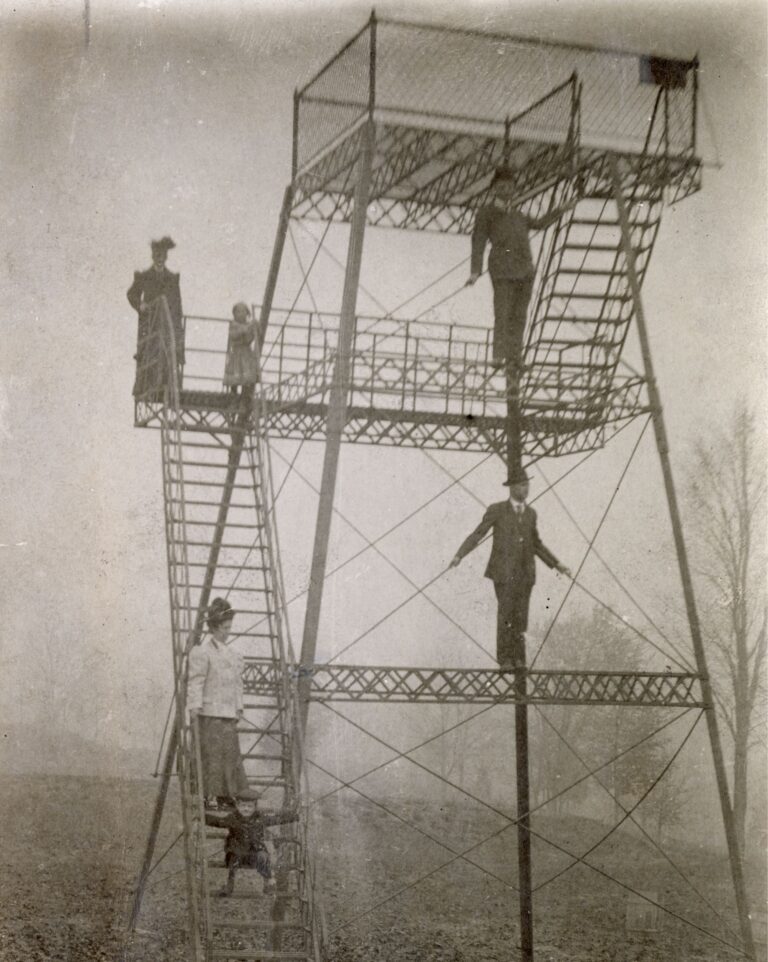
The Serpent Mound Tower
History
The Columbus Wire and Iron Works Company built the Serpent Mound Observation Tower in 1908. It is made of 6,000 pounds, or three tons, of steel. To build such a tower today would cost $250,000.
The tower is 25 feet high and provides a view of the entire Serpent. Because of the size of Serpent Mound and the way it winds across the landscape, it is not possible to see the entire mound from any one spot on the ground. The tower offers visitors a dramatic view of the Serpent from one scenic overlook.
How did American Indians see the Serpent?
The American Indians who built Serpent Mound never saw the entire mound from a single vantage point. Instead, they saw the Serpent by walking and perhaps dancing around its entire length. In this way, the story written here in the earth slowly emerged as they followed the undulations of the Serpent from its uncoiling spiral tail at one end of the bluff to its head at the other. That is still the best way to experience Serpent Mound!

Frequently Asked Questions
The observation tower was closed in 2022 because it required restoration and structural reinforcement. A structural engineering study determined the tower's condition and recommended immediate closure until restoration could be completed. In its current condition, it would be potentially hazardous to use.
No single event caused damage to the tower, which was built in 1908. Its state is the result of the gradual degradation that comes with age, weather, and heavy sustained usage. The metal of the tower has been corroded over time, including essential structural members. The old framing can no longer reliably carry the structural load and must be reinforced. In addition, the concrete foundations under the tower's legs must be replaced. Finally, there is a need to remove lead paint and make safety improvements to the steps and railings.
A project of this magnitude takes significant periods of planning, funding, consultation, design, and construction. A project of this scale would normally be scheduled years in advance as part of regular capital planning.
We did not have that time to prepare for restoration of the tower. In late 2021, a cursory examination by a structural engineer suggested the need for a detailed study to determine the integrity of the structure. A structural engineering consultant was hired to conduct the study, which indicated defects in the structure and foundation. After the results were known, additional work, such as cost estimation, was needed to determine the next steps. Discussion and consultation led to the decision to repair the tower. Options for funding were considered and pursued, leading to full funding through the Appalachian Community Grant Program. A staff architect has worked with consultants to complete the design phase and prepare for construction. A small archaeological excavation was undertaken at the base of the tower to assess any adverse impacts to unknown subsurface cultural resources; no such resources were found during excavation. Although there have been many steps in this process, securing funding required the most time.
The tower is an historically significant structure. It was built in 1908 by the Columbus Wire and Iron Works Company using 6,000 pounds, or three tons, of steel. The tower is 25 feet high and provides a view of the entire Serpent Mound. Because of the size of Serpent Mound and the way it winds its way across the landscape, it is not possible to see the entire mound from any one spot on the ground. The tower offers visitors a dramatic view of the Serpent from one scenic overlook.
The observation tower has been used by visitors for more than a century and due to its longevity, it has become part of the Serpent Mound experience and its continuing story. Repairing the tower will ensure that future visitors will be able to climb the same tower that has hosted millions of footsteps to see the effigy since 1908.
Serpent Mound is operated and directly managed by the Ohio History Connection, which is responsible for nearly 60 historic and archaeological sites around the state. The Ohio History Connection conducts reviews and inspections through site visits by staff architects, engineers, maintenance staff, archaeologists, and contractors to identify and fix problems.
The tower restoration project is overseen by a staff architect with expertise in the care of historic structures. A cross-department team supports all aspects of the project. For example, a staff archaeologist has been assigned to the project to prevent any adverse impacts to cultural resources. Restoration planning was undertaken in coordination with the State Historic Preservation Office and in consultation with Tribal partners from multiple federally recognized tribes. Since Serpent Mound is a National Historic Landmark and the tower is a historically significant structure, staff also consulted with the National Park Service on this project.
This project has been funded by a grant from the Appalachian Community Grant Program (ACGP) for an amount not to exceed $862,000. Program funds are provided by Ohio's designation of American Rescue Plan Act (ARPA) dollars. The grant program is administered by the Governor’s Office of Appalachia within the Ohio Department of Development. Ross County is serving as the project sponsor. These grants have significant procedural and reporting requirements. Numerous other projects in southwest Ohio have also been funded by ACGP funds but are separate projects from the tower restoration.
Restoration began in late September. The project is contracted for 120 days of construction, although delays or follow-up activities may extend that timeline into 2026. The Ohio History Connection will make an announcement about the reopening date of the tower in 2026, and a public event will be scheduled for the official reopening.
Serpent Mound will remain open on its normal schedule throughout construction (Tue – Sat, 10 a.m. to 5 p.m.; Sun, 12 to 5 p.m.). Late in the calendar year, Serpent will switch to the normal winter schedule, which is the same except that the site will be closed on Tuesdays.
Visitors should anticipate construction noise and blockage of the paved path adjacent to the tower. Visitors will be able to access most of the site in the same way as normal.
Construction fencing will be assembled around the tower and around a construction corridor leading from the tower to the parking lot. This corridor is where thick matting will be laid down to prevent ground disturbance from heavy equipment. Approximately one-third of the parking lot will be blocked off as a lay-down area for contractor equipment. Although there should be plenty of available parking, long vehicles like RVs or buses may have a tighter turn to exit the parking lot.
During construction, visitors will be able to use the paved path to approach the Serpent along the western leg of the loop. Visitors will be able to approach virtually all of the Serpent, except for the portion immediately adjacent to the tower, which will be blocked by construction fencing. As a result, visitors will approach and leave by the same western leg of the path. Visitors will be able to walk to the effigy from the Visitor's Center. A ramp for wheelchair access will be added over matting that overlaps with the paved path near the tower.
The tower will look similar after restoration. The process being undertaken is intentionally additive, not subtractive, so historic elements will remain but will be reinforced with new steel. The tower will be stripped of lead paint and repainted. The tower’s top of footing elevations were raised to prolong the service life of the tower upon completion of the repairs/reinforcement. This change limits soil to steel contact, limiting the moisture exposure and thus corrosion of the steel. Additionally, the top of footing elevations are the same for each column leg of the tower, making the tower more symmetrical and thus increasing the stability of the tower.
The Ohio History Connection will announce the reopening date of the tower in 2026 and a public event will be scheduled for the official reopening.
Stay tuned for updates on this page and follow Serpent Mound and the Ohio History Connection’s social media accounts for updates and announcements.
